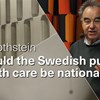sons
Socioeconomic Persistence Across Generations: Cognitive and Noncognitive Processes
Kapitel 3. http://www.russellsage.org/publications/parents-to-children Abstract This chapter analyses the role of cognitive ability, personality traits, and physical characteristics in transmission of so
A Life‐Course Analysis of Geographical Distance to Siblings, Parents, and Grandparents in Sweden
Population, Space and Place, VolumLäe 23, Issue 3, e2020, doi.org/10.1002/psp.2020 Abstract This study makes a contribution to the demography and geography of kinship by studying how internal migration
The Role of Education for Intergenerational Income Mobility: A comparison of the United States, Great Britain, and Sweden
Social Forces, Volume 96, Issue 1, pp. 121–152, doi.org/10.1093/sf/sox051 Abstract Previous studies have found that intergenerational income persistence is relatively high in the United States and Brita
Luc Bovens: Secular Hopes in the Face of Death
Professor, University of North Carolina, Chapel Hill. ABSTRACT We will discuss various questions concerning secular hopes in the face of death, that is, hopes other than the hope for eternal life. What
Applying spatial regression to evaluate risk factors for microbiological contamination of urban groundwater sources in Juba, South Sudan
Hydrogeology Journal 25(4) pp. 1077-1091, doi: 10.1007/s10040-016-1504-x Abstract This study developed methodology for statistically assessing groundwater contamination mechanisms. It focused on microbiahumanitarian aid organisation Médecins Sans Frontières in 2010. The factors included hydrogeological settings, land use and socio-economic characteristics. The results showed that the residuals of a conventional probit regression model had a significant positive spatial autocorrelation (Moran’s I =3.05, I-stat = 9.28); therefore, a spatial model was developed that had better goodness-of-fit to the observations. The mostsignificant factor in this model (p-value 0.005) was the distance from a water source to the nearest Tukul area, an area with informal settlements that lack sanitation services. It is thus recommended that future remediation and monitoring efforts in the city be concentrated in such low-income regions. The spatial model differed from the conventional approach: in contrast with the latter case, lowland topography was not significant at the 5% level, as the p-value was 0.074 in the spatial model and 0.040 in the traditional model. This study showed that statistical risk-factor assessments of groundwater contamination need to consider spatial interactions when the water sources are located close to each other. Future studies might further investigate the cut-off distance that reflects spatial autocorrelation. Particularly, these results advise research on urban groundwater quality.
Bo Rothstein: Should the Swedish Public Health Care be Nationalized? Consequences for Democracy, Legitimacy and Accountability.
Venue: Institute for Futures Studies, Holländargatan 13 in Stockholm Research seminar with Bo Rothstein, who holds the August Röhss Chair in Political Science at University of Gothenburg, a position est

Bo Rothstein: Should the Swedish Public Health Care be Nationalized?
Research seminar with Bo Rothstein, who holds the August Röhss Chair in Political Science at University of Gothenburg, a position established by a donation to the university in 1901. His research conc
The Oxford Handbook of Population Ethics - Interview with the editors
If we can affect how many people will be born in the future, what does that mean for our decisions today? Would it be bad if much fewer people would exist in the future, as an adaption to climate chan
Gustaf Arrhenius more information
Current and Recent Projects The Mimir Institute for Long Term Futures Studies Climate Ethics and Future Generations Sustainable Population in the Time of Climate Change Anxieties of Democracy The Boundary








